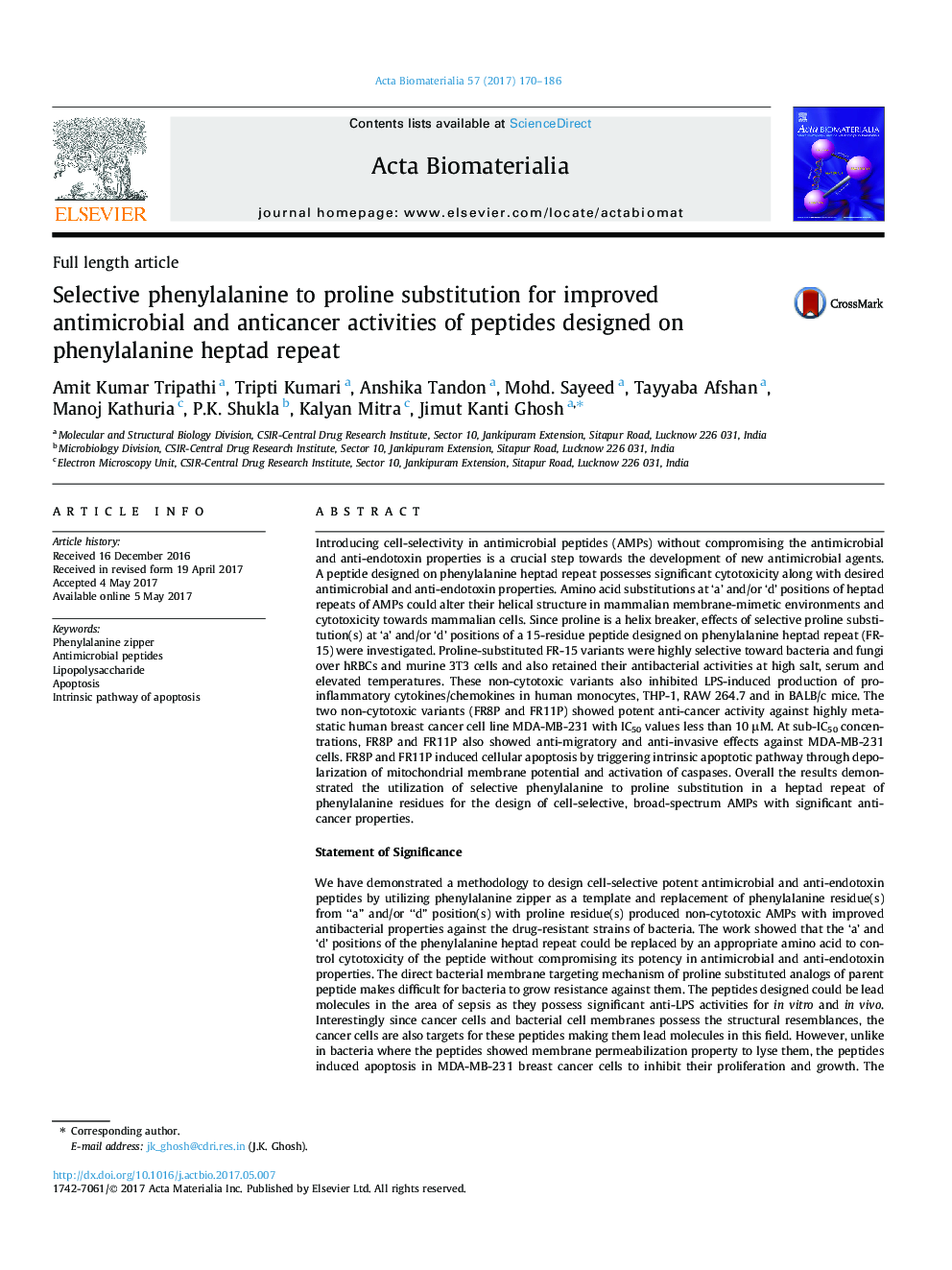| کد مقاله | کد نشریه | سال انتشار | مقاله انگلیسی | نسخه تمام متن |
|---|---|---|---|---|
| 6449115 | 1415929 | 2017 | 17 صفحه PDF | دانلود رایگان |
Introducing cell-selectivity in antimicrobial peptides (AMPs) without compromising the antimicrobial and anti-endotoxin properties is a crucial step towards the development of new antimicrobial agents. A peptide designed on phenylalanine heptad repeat possesses significant cytotoxicity along with desired antimicrobial and anti-endotoxin properties. Amino acid substitutions at 'a' and/or 'd' positions of heptad repeats of AMPs could alter their helical structure in mammalian membrane-mimetic environments and cytotoxicity towards mammalian cells. Since proline is a helix breaker, effects of selective proline substitution(s) at 'a' and/or 'd' positions of a 15-residue peptide designed on phenylalanine heptad repeat (FR-15) were investigated. Proline-substituted FR-15 variants were highly selective toward bacteria and fungi over hRBCs and murine 3T3 cells and also retained their antibacterial activities at high salt, serum and elevated temperatures. These non-cytotoxic variants also inhibited LPS-induced production of pro-inflammatory cytokines/chemokines in human monocytes, THP-1, RAW 264.7 and in BALB/c mice. The two non-cytotoxic variants (FR8P and FR11P) showed potent anti-cancer activity against highly metastatic human breast cancer cell line MDA-MB-231 with IC50 values less than 10 μM. At sub-IC50 concentrations, FR8P and FR11P also showed anti-migratory and anti-invasive effects against MDA-MB-231 cells. FR8P and FR11P induced cellular apoptosis by triggering intrinsic apoptotic pathway through depolarization of mitochondrial membrane potential and activation of caspases. Overall the results demonstrated the utilization of selective phenylalanine to proline substitution in a heptad repeat of phenylalanine residues for the design of cell-selective, broad-spectrum AMPs with significant anti-cancer properties.Statement of SignificanceWe have demonstrated a methodology to design cell-selective potent antimicrobial and anti-endotoxin peptides by utilizing phenylalanine zipper as a template and replacement of phenylalanine residue(s) from “a” and/or “d” position(s) with proline residue(s) produced non-cytotoxic AMPs with improved antibacterial properties against the drug-resistant strains of bacteria. The work showed that the 'a' and 'd' positions of the phenylalanine heptad repeat could be replaced by an appropriate amino acid to control cytotoxicity of the peptide without compromising its potency in antimicrobial and anti-endotoxin properties. The direct bacterial membrane targeting mechanism of proline substituted analogs of parent peptide makes difficult for bacteria to grow resistance against them. The peptides designed could be lead molecules in the area of sepsis as they possess significant anti-LPS activities for in vitro and in vivo. Interestingly since cancer cells and bacterial cell membranes possess the structural resemblances, the cancer cells are also targets for these peptides making them lead molecules in this field. However, unlike in bacteria where the peptides showed membrane permeabilization property to lyse them, the peptides induced apoptosis in MDA-MB-231 breast cancer cells to inhibit their proliferation and growth. The results are significant because it reveals that “a” and “d” positions of a phenylalanine zipper can be utilized as switches to design cell-selective, antimicrobial, anti-endotoxin and anticancer peptides.
141
Journal: Acta Biomaterialia - Volume 57, 15 July 2017, Pages 170-186
